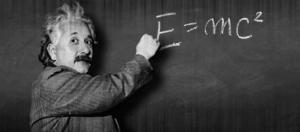Blog
Heart of the Matter
8 May 2015
 F. Schmutzer
F. SchmutzerEinstein’s last paper of 1905 is the shortest of them all.1 A mere two pages, “Does the Inertia of a Body Depend Upon Its Energy Content?” looks at aspects of his special relativity paper in more detail. The paper reads like a casual hypothesis. Almost “here’s a crazy idea, and it might explain a few odd things.” What Einstein derives is his most famous equation, E = mc2.
The equation doesn’t actually appear in the paper, but is trivially derived from its results. In the work, Einstein noted that the relative nature of time and space meant that the kinetic and potential energy of a mass were also relative to the observer. Normally these would be the sum total energy of a mass, but if this was the case the energy of a mass wouldn’t be conserved. So Einstein derived a relativistic energy relation such that energy would be conserved. In doing this, he demonstrated that a mass should have a mass energy or “rest energy” in addition to its kinetic and potential energies. This connection between a body’s mass and its energy is what the famous equation represents.
At the end of the paper Einstein notes that this relation might explain the strange behavior of radium salts, which seemed to emit particles with far more energy than could be produced by simple chemistry. He turned out to be right, because not only are mass and energy connected, but mass can become energy and energy can become mass. We now know that radium emits high energy particles by transmuting into other elements that have less mass. The lost mass is transformed into energy.
As an astronomer, the most impressive aspect of this short work is the fact that it gave us a real understanding of the stars. In the 1800s the only known mechanism by which the Sun and stars could shine was through gravitational heating. Just as putty can get warm if you squeeze it, the Sun could be heated by its gravitational weight. But this would only allow a star to shine for about 20 million years, and geology had clearly shown the Earth was millions if not billions of years old. Einstein’s famous equation solved that problem. The sun and stars are mostly made of the light elements hydrogen and helium, and those can’t be split into lighter elements. But perhaps the tremendous heat and pressure of a sun’s core could fuse lighter elements into heavier ones. In 1939, Hans Bethe demonstrated how four hydrogen atoms could be fused into a single helium atom. A helium atom has less mass than four hydrogen, so the result was helium plus energy. We then learned how helium could become carbon, nitrogen and oxygen, and on to heavier and heavier elements, all producing energy along the way.
This gave us far more answers than we expected. It not only gave us fusion as the source of a star’s power, but eventually explained from whence the diversity of elements came. Hydrogen and helium fusing into heavier elements. Exploding stars scattering those elements across the cosmos. New stars forming, with planets, one of which is home to us. From a single, simple equation we came to know that we are the dust of stars.
Did you miss the beginning of this series? It all starts here.
Einstein, Albert. “Ist die Trägheit eines Körpers von seinem Energieinhalt abhängig?.” Annalen der Physik 323.13 (1905): 639-641. ↩︎